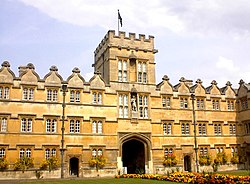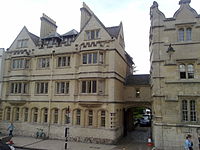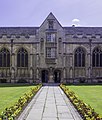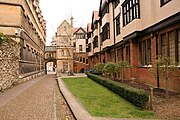University College, Oxford
| University College Latin: Collegium Magnae Aulae Universitatis Oxon
| |||||||||||
 The Quad in University College | |||||||||||
|---|---|---|---|---|---|---|---|---|---|---|---|
 | |||||||||||
| Principal: | |||||||||||
| Website: | www.univ.ox.ac.uk | ||||||||||
| |||||||||||
| Location | |||||||||||
| Grid reference: | SP51730624 | ||||||||||
| Location: | 51°45’9"N, 1°15’7"W | ||||||||||
University College (in full The College of the Great Hall of the University of Oxford,[1][2] is a constituent college of the University of Oxford, standing in the heart of Oxford. It has a claim to being the oldest college of the university, having been founded in 1249 by William of Durham.
As of 2018, the college had an estimated financial endowment of £132.7 million.[3]
The college is associated with a number of influential people, including Clement Attlee, Harold Wilson, Bill Clinton, Neil Gorsuch, Stephen Hawking, C. S. Lewis, V. S. Naipaul, Robert Reich, William Beveridge, Bob Hawke, Robert Cecil, and Percy Bysshe Shelley.
History
A legend arose in the 14th century that the college was founded by King Alfred in 872. This explains why the college arms are those attributed to King Alfred, why the Visitor is always the reigning monarch, and why the college celebrated its millennium in 1872. Most agree that in reality the college was founded in 1249 by William of Durham. He bequeathed money to support ten or twelve masters of arts studying divinity, and a property which became known as Aula Universitatis (University Hall) was bought in 1253.[4] This later date still allows the claim that Univ is the oldest of the Oxford colleges, although this is contested by Balliol College and Merton College. The college was only open to fellows studying theology until the 16th century.
The college acquired four properties on its current site south of the High Street in 1332 and 1336 and built a quadrangle in the 15th century.[5] As it grew in size and wealth, its mediæval buildings were replaced with the current Main Quadrangle in the 17th century. Although the foundation stone was placed on 17 April 1634, the disruption of the Civil War meant it was not completed until some time in 1676.[1] Radcliffe Quad followed more rapidly by 1719, and the library was built in 1861.
Like many of Oxford's colleges, University College accepted its first mixed-sex cohort in 1979, having previously been an institution for men only.[6]
Buildings

The main entrance to the college is on the High Street and its grounds are bounded by Merton Street and Magpie Lane. The college is divided by Logic Lane, which is owned by the college and runs through the centre. The western side of the college is occupied by the library, the hall, the chapel and the two quadrangles which house both student accommodation and college offices. The eastern side of the college is mainly devoted to student accommodation in rooms above the High Street shops, on Merton Street or in the separate Goodhart Building. This building is named after former master of the college, Arthur Lehman Goodhart.
A specially constructed building in the college, the Shelley Memorial, houses a statue by Edward Onslow Ford of the poet Percy Bysshe Shelley – a former member of the college, who was sent down for writing The Necessity of Atheism (1811), along with his friend Thomas Jefferson Hogg. Shelley is depicted lying dead on the Italian seashore.[7]
The college annexe on Staverton Road in North Oxford houses undergraduate students during their second year and some graduate students.[8]
The college also owns the University College Boathouse (completed in 2007 and designed by Belsize architects)[9] and a sports ground, which is located nearby on Abingdon Road.[10]
Grace
University has the longest grace of any Oxford (and perhaps Cambridge) college.[11] It is read before every Formal Hall, which is held Tuesday, Thursday, and Sunday at Univ. The reading is performed by a Scholar of the college and whoever is sitting at the head of High Table (typically the Master or the most senior Fellow at the table if the Master is not dining). The Scholar does not need to know it by heart, and it is unusual for people to do so.
The original text is:
- Gratiarum actio in collegio magnae aulae universitatis quotidie ante mensam dicenda.
- Scholar – Benedictus sit Deus in donis suis.
- Response – Et sanctus in omnibus operibus suis.
- Scholar – Adiutorium nostrum in Nomine Domini.
- Response – Qui fecit coelum et terram.'
- Scholar – Sit Nomen Domini benedictum.'
- Response – Ab hoc tempore usque in saecula.
- Scholar – Domine Deus, Resurrectio et Vita credentium, Qui semper es laudandus tam in viventibus quam in defunctis, gratias Tibi agimus pro omnibus Fundatoribus caeterisque Benefactoribus nostris, quorum beneficiis hic ad pietatem et ad studia literarum alimur: Te rogantes ut nos, hisce Tuis donis ad Tuam gloriam recte utentes, una cum iis ad vitam immortalem perducamur. Per Jesum Christum Dominum nostrum. Amen.
- Scholar – Deus det vivis gratiam, defunctis requiem: Ecclesiae, Reginae, Regnoque nostro, pacem et concordiam: et nobis peccatoribus vitam aeternam. Amen.
English translation
- The Grace that must be said every day before dinner in University College.
- Scholar – Blessed be God in his gifts.
- Response – And holy in all his works.'
- Scholar – Our help is in the name of the Lord.
- Response – Who has made heaven and earth.
- Scholar – May the name of the Lord be blessed.
- Response – From this time and for evermore.
- Scholar – Lord God, the Resurrection and Life of those who believe, You are always to be praised as much among the living as among the departed. We give You thanks for all our founders and our other benefactors, by whose benefactions we are nourished here for piety and for the study of letters. And we ask you that we, rightly using these Your gifts to Your glory, may be brought with them to immortal life. Through Jesus Christ our Lord, Amen.
- Scholar – May God give grace to the living, rest to the departed; peace and concord to the Church, the Queen and our Kingdom; and to us sinners, eternal life. Amen.
Publications
The college produces a number of regular publications, especially for alumni.[12]
University College Record
The University College Record is the annual magazine sent to alumni of the college each autumn. The magazine provides college news on clubs and societies such as the University College Players and the Devas Club, as well as academic performance and prizes. News about and obituaries of former students are included at the end of each issue.
Editors have included the literary critic Peter Bayley and the historian Leslie Mitchell.
The Martlet
The Martlet is a magazine for members and friends of the college, available in print and online.[12]
Gallery
-
University College, on the south side of the High Street.
-
University College, Oxford: aerial view with key and scale.
-
Main Quadrangle of the college.
-
The Shelley Memorial at University College, Oxford.
-
The interior of the chapel of University College, Oxford.
-
University College, Oxford: the library. Line engraving by J.H. Le Keux, 1861, after himself.
-
Courtyard of University College Oxford.
-
The new Boathouse for the University College Oxford Boat Club.
-
Dr Bowen's Room, University College, Oxford.
-
A view of Logic Lane toward the High Street from within University College, Oxford.
Outside links
| ("Wikimedia Commons" has material about University College, Oxford) |
References
- ↑ 1.0 1.1 Darwall-Smith, Robin (2008). A History of University College, Oxford. Oxford University Press. ISBN 978-0-19-928429-0. https://books.google.com/books?id=zrCfAAAAMAAJ.
- ↑ Carr, William, [University College], Routledge, 1998. ISBN 978-0-415-18632-2.
- ↑ "University College Oxford: Annual Report and Financial Statements: Year ended 31 July 2018". p. 28. http://d307gmaoxpdmsg.cloudfront.net/collegeaccounts1718/University_College.pdf.
- ↑ "Oxford History". http://www.oxfordhistory.org.uk/high/tour/south/university_college.html.
- ↑ A History of the County of Oxford - Volume 3 pp 61-81: University College (Victoria County History)
- ↑ "History - University College Oxford" (in en-GB). University College Oxford. https://www.univ.ox.ac.uk/about/history/.
- ↑ "Shelley Memorial" (in en-GB). https://www.univ.ox.ac.uk/college_building/shelley-memorial/.
- ↑ "University College - Oxford University Alternative Prospectus" (in en). https://apply.oxfordsu.org/colleges/univ/.
- ↑ "University College Oxford Boathouse", e-architect.
- ↑ "Univ Buildings Elsewhere" (in en-GB). https://www.univ.ox.ac.uk/college_building/univ-buildings-elsewhere/.
- ↑ "Food - University College Oxford (Univ) - Food at Univ" (in en-GB). https://www.univ.ox.ac.uk/live-at-univ/food/.
- ↑ 12.0 12.1 "Publications". UK: University College, Oxford. https://www.univ.ox.ac.uk/alumni/publications/.
| Colleges of the University of Oxford | |
|---|---|
| Colleges:
All Souls • Balliol • Brasenose • Christ Church • Corpus Christi • Exeter • Green Templeton • Harris Manchester • Hertford • Jesus • Keble • Kellogg • Lady Margaret Hall • Linacre • Lincoln • Magdalen • Mansfield • Merton • New College • Nuffield • Oriel • Pembroke • The Queen's • Reuben • St Anne's • St Antony's • St Catherine's • St Cross • St Edmund Hall • St Hilda's • St Hugh's • St John's • St Peter's • Somerville • Trinity • University • Wadham • Wolfson • Worcester |
 |
| Permanent private halls:
Blackfriars • Campion Hall • Regent's Park College • St Benet's Hall • St Stephen's House • Wycliffe Hall | |










